DOI: https://doi.org/10.1038/s41467-024-47240-5
PMID: https://pubmed.ncbi.nlm.nih.gov/38594234
تاريخ النشر: 2024-04-09
تمكين توهج عضوي أزرق دائري الاستقطاب قوي من خلال صبغة كيرالية معزولة ذات احتواء ذاتي
تم القبول: 25 مارس 2024
نُشر على الإنترنت: 09 أبريل 2024
(أ) التحقق من التحديثات
الملخص
إن إنشاء نظام توهج عضوي مستقطب دائريًا بمستويات طاقة ثلاثية مرتفعة، وانتقالات غير إشعاعية مكبوتة، وفعالية في اللولبية، وهي ثلاثة متطلبات حاسمة لتحقيق توهج أزرق مستقطب دائريًا، قد شكل تحديًا كبيرًا. هنا، يتم الكشف عن نهج بسيط لتحقيق مواد توهج أزرق مستقطب دائريًا من خلال حصر كيميائي ذاتي للمادة الملونة اللولبية المعزولة داخل مصفوفة بوليمرية. إن تشكيل روابط هيدروجينية قوية داخل المصفوفة البوليمرية يمنح حالة جزيئية معزولة ومستقرة بشكل واضح للكروموفورات اللولبية، مما يمنح نطاق انبعاث أزرق عند 414 نانومتر، ومدة حياة تبلغ 3.0 ثانية، وعامل عدم التماثل اللمعي لـ
استراتيجيات المضيف-الضيف متعددة المكونات
النتائج
تصميم المواد وتخليقها
تصميم، زوج من الإناتوميرات ذات مستوى طاقة ثلاثي عالي (الأشكال التكميلية 1-15)،
الخصائص الفوتوفيزيائية لبوليمر CPOA الأزرق
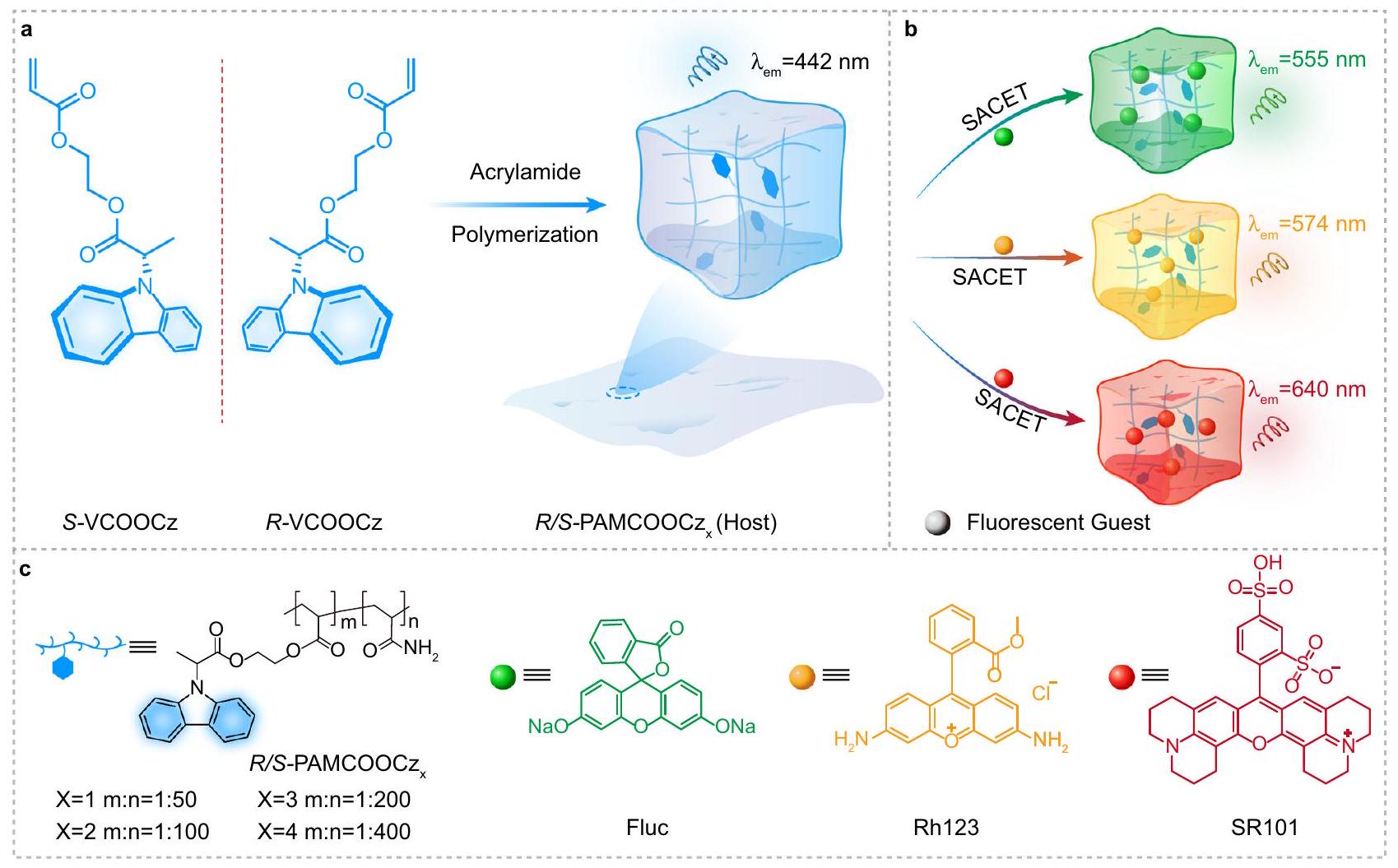
تألق تآزري بعدي وانتقال طاقة اللولبية (SACET) لتحقيق بوليمرات CPOA كاملة الألوان. هياكل جزيئية لـ PAMCOOCz
نطاق الامتصاص عند
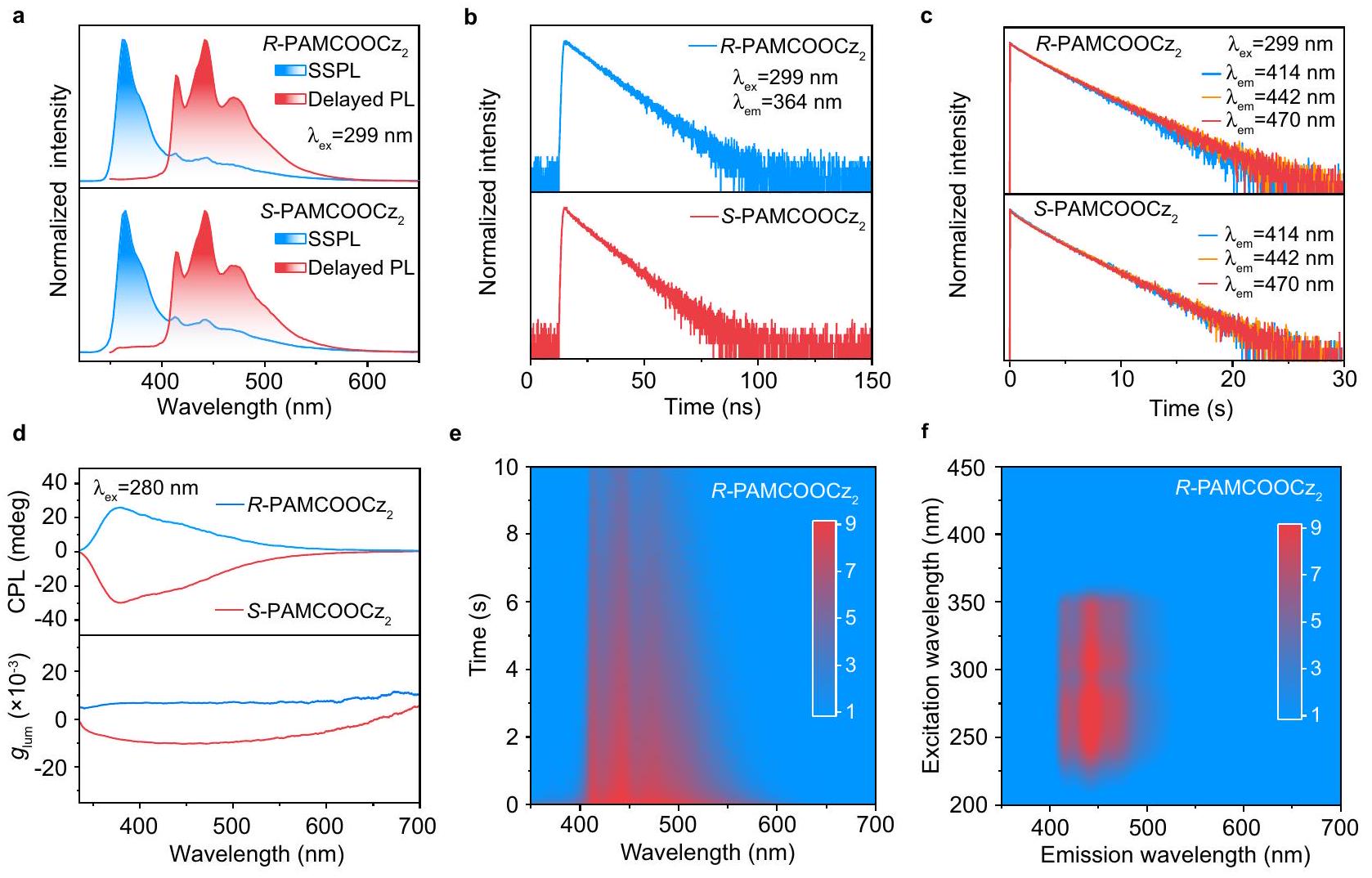
عرض وتحقيق في SACET
تمكين بوليمرات CPOA متعددة الألوان
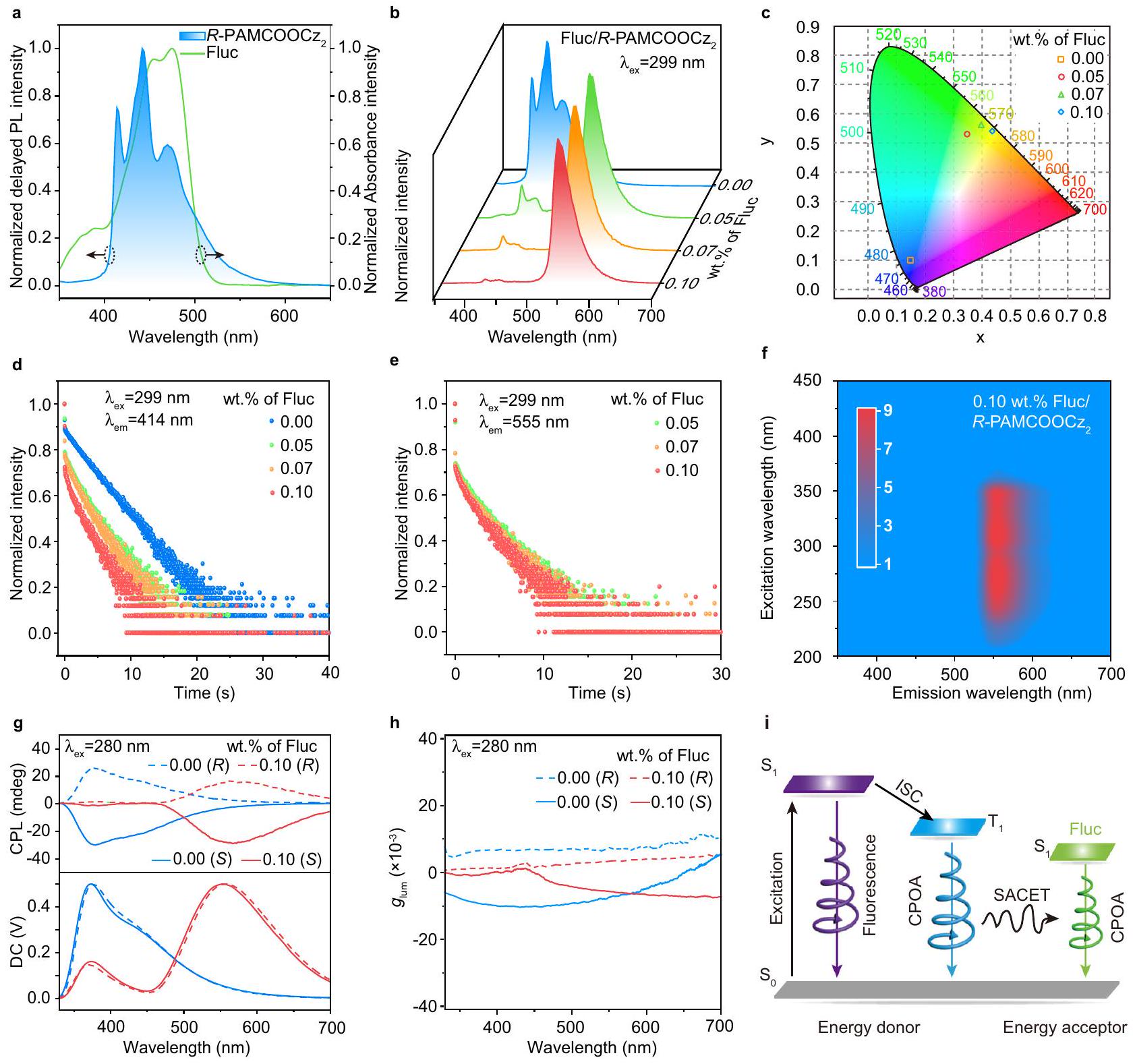
وزن
التطبيقات المحتملة لمواد CPOA
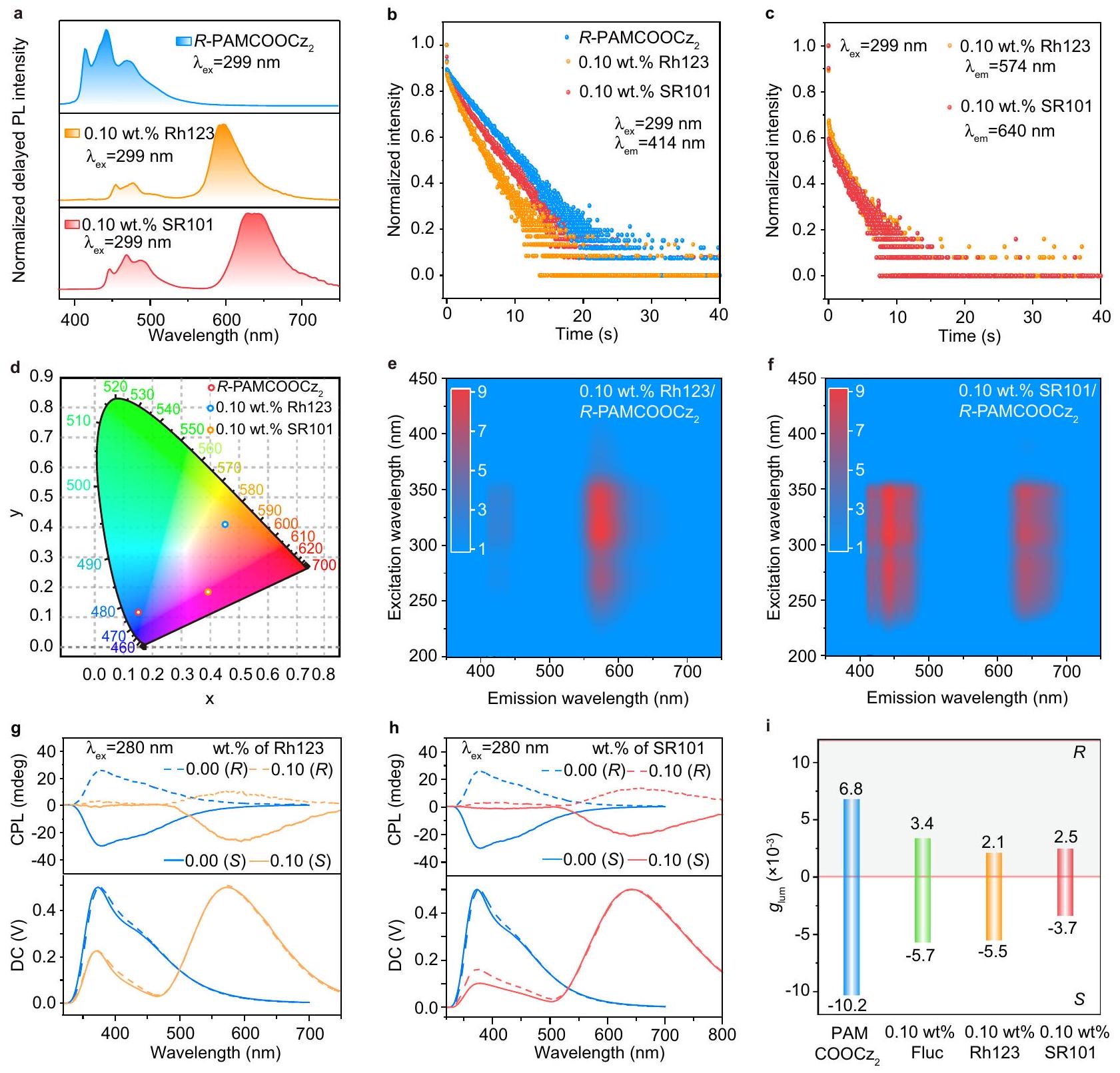
تم استكشاف تشفير المعلومات المتعددة الوظائف، وتفعيل الألياف والأجسام ثلاثية الأبعاد. كما هو موضح في الشكل 5a، تشمل المواد المتلألئة المختلفة بما في ذلك المواد اللولبية
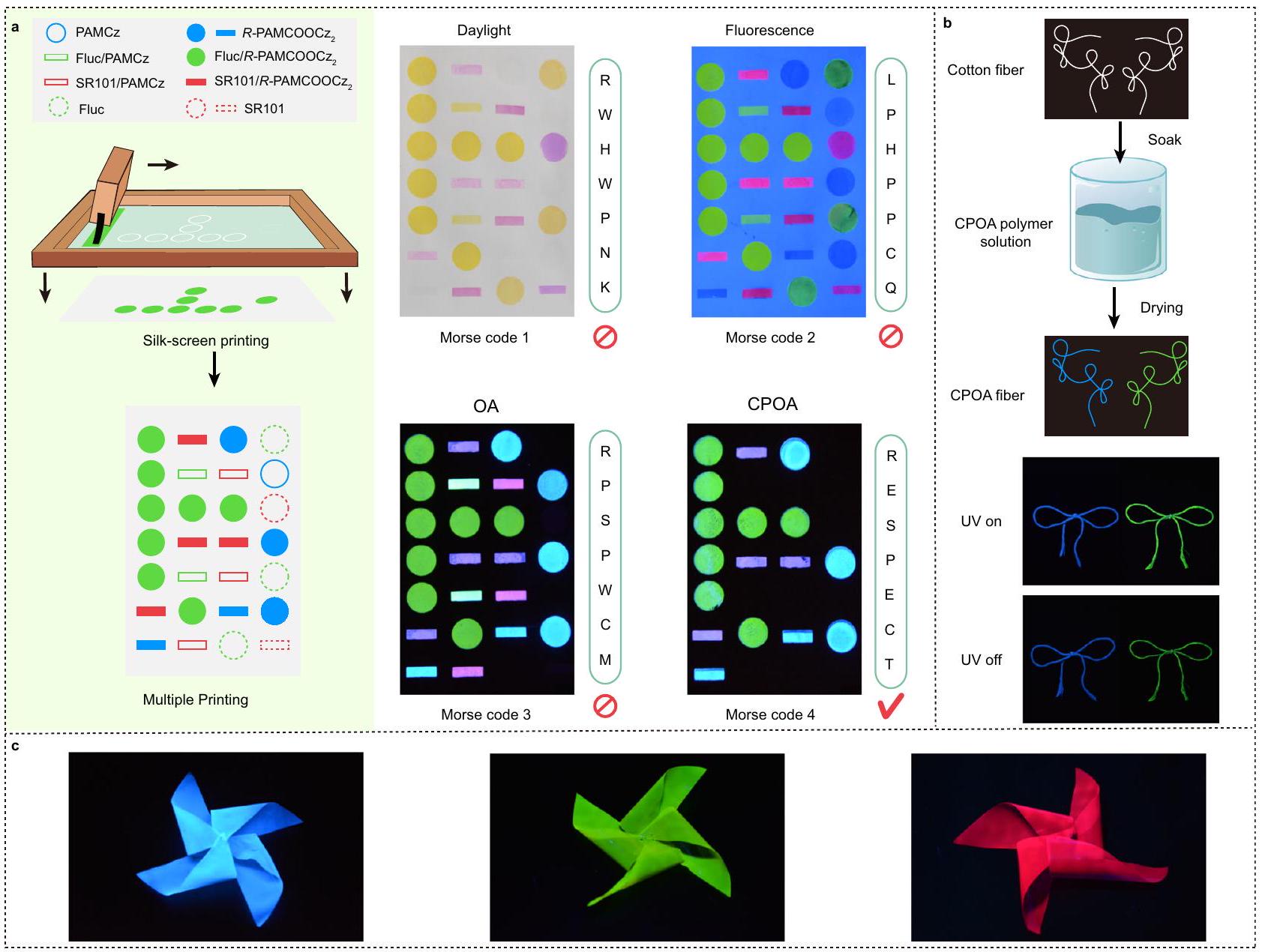
نقاش
طرق
المواد
(97%)، 2-هيدروكسي إيثيل أكريلات (99%)، أكريلاميد (99.9%)، فلوريسئين صوديوم (
الإجراء العام للبلمرة الجذرية
S-PAMCOOCz
R-PAMCOOCz
S-PAMCOOCz
S-PAMCOOCz
تحضير أفلام بوليمرية ملونة بالكامل
توفر البيانات
References
- Song, I. et al. Helical polymers for dissymmetric circularly polarized light imaging. Nature 617, 92-99 (2023).
- Pacchioni, G. A chiral glass delivers color-tunable ultralong roomtemperature phosphorescence. Nat. Rev. Mater. 8, 362-362 (2023).
- Yang, Y., da Costa, R. C., Fuchter, M. J. & Campbell, A. J. Circularly polarized light detection by a chiral organic semiconductor transistor. Nat. Photonics 7, 634-638 (2013).
- Qian, Q. et al. Chiral molecular intercalation superlattices. Nature 606, 902-908 (2022).
- Wan, L., Liu, Y., Fuchter, M. J. & Yan, B. Anomalous circularly polarized light emission in organic light-emitting diodes caused by orbital-momentum locking. Nat. Photonics 17, 193-199 (2023).
- MacKenzie, L. E. & Pal, R. Circularly polarized lanthanide luminescence for advanced security inks. Nat. Rev. Chem. 5, 109-124 (2021).
- Zhan, X. et al. 3D laser displays based on circularly polarized lasing from cholesteric liquid crystal arrays. Adv. Mater. 33, 2104418 (2021).
- Jia, J. et al. Circularly polarized electroluminescence from a singlecrystal organic microcavity light-emitting diode based on photonic spin-orbit interactions. Nat. Commun. 14, 31 (2023).
- Li, H. et al. Single-component color-tunable circularly polarized organic afterglow through chiral clusterization. Nat. Commun. 13, 429 (2022).
- Gu, L. et al. Circularly polarized organic room temperature phosphorescence from amorphous copolymers. J. Am. Chem. Soc. 143, 18527-18535 (2021).
- Hu, Y., Huang, Z., Willner, I. & Ma, X. Multicolor circularly polarized luminescence of a single-component system revealing multiple information encryption. CCS Chem. 6, 518-527 (2024).
- Lin, S. et al. Photo-triggered full-color circularly polarized luminescence based on photonic capsules for multilevel information encryption. Nat. Commun. 14, 3005 (2023).
- Yu, H. J. et al. Photooxidation-driven purely organic roomtemperature phosphorescent lysosome-targeted imaging. J. Am. Chem. Soc. 143, 13887-13894 (2021).
- Pan, X. et al. A low-temperature-resistant flexible organic crystal with circularly polarized luminescence. Angew. Chem. Int. Ed. 61, e202203938 (2022).
- Liu, G. et al. Photocyclization-induced emission enhancement and circularly polarized luminescence inversion of achiral emitters in co-assembled gels. Small Struct. 3, 2200209 (2022).
- Yuan, Y. X. et al. Fluorescent TPE macrocycle relayed lightharvesting system for bright customized-color circularly polarized luminescence. J. Am. Chem. Soc. 144, 5389-5399 (2022).
- Liu, N., Gao, R. T. & Wu, Z. Q. Helix-induced asymmetric self-assembly of
-conjugated block copolymers: from controlled syntheses to distinct properties. Acc. Chem. Res. 56, 2954-2967 (2023). - Xu, X. H. et al. Precise synthesis of optically active and thermodegradable poly(trifluoromethyl methylene) with circularly polarized luminescence. Angew. Chem. Int. Ed. 62, e202300882 (2023).
- Wang, C., Xu, L., Zhou, L., Liu, N. & Wu, Z. Q. Asymmetric living supramolecular polymerization: precise fabrication of one-handed helical supramolecular polymers. Angew. Chem. Int. Ed. 61, e202207028 (2022).
- Nie, F., Wang, K. Z. & Yan, D. P. Supramolecular glasses with colortunable circularly polarized afterglow through evaporationinduced self-assembly of chiral metal-organic complexes. Nat. Commun. 14, 1654 (2023).
- Shang, W. et al. Chiral reticular self-assembly of achiral AIEgen into optically pure metal-organic frameworks (MOFs) with dual mechano-switchable circularly polarized luminescence. Angew. Chem. Int. Ed. 59, 12811-12816 (2020).
- Sumsalee, P. et al. Luminescent chiral exciplexes with sky-blue and green circularly polarized-thermally activated delayed fluorescence. Chem. Eur. J. 27, 16505-16511 (2021).
- Yan, Z. P. et al. A chiral dual-core organoboron structure realizes dual-channel enhanced ultrapure blue emission and highly efficient circularly polarized electroluminescence. Adv. Mater. 34, 2204253 (2022).
- Ahn, J. et al. Chiral organic semiconducting materials for nextgeneration optoelectronic sensors. Device 1, 100176 (2023).
- Wu, X. G., Yan, X. Q., Chen, Y., Zhu, W. G. & Chou, P. T. Advances in organic materials for chiral luminescence-based OLEDs. Trends Chem. 5, 734-747 (2023).
- Xu, L. et al. Visible helicity induction and memory in polyallene toward circularly polarized luminescence, helicity discrimination, and enantiomer separation. Angew. Chem. Int. Ed. 62, e202217234 (2023).
- Garain, S., Sarkar, S., Chandra Garain, B., Pati, S. K. & George, S. J. Chiral arylene diimide phosphors: circularly polarized ambient phosphorescence from bischromophoric pyromellitic diimides. Angew. Chem. Int. Ed. 61, e202115773 (2022).
- Huang, W., Fu, C., Liang, Z., Zhou, K. & He, Z. Strong circularlypolarized room-temperature phosphorescence from a feasibly separable scaffold of bidibenzo[b,d]furan with locked axial chirality. Angew. Chem. Int. Ed. 61, e202202977 (2022).
- Zhang, D. W., Li, M. & Chen, C. F. Linear axially chiral conjugated polymers exhibiting ultralong low-temperature phosphorescence and intense circularly polarized luminescence. Angew. Chem. Int. Ed. 61, e202213130 (2022).
- Nie, F. & Yan, D. P. Macroscopic assembly of chiral hydrogenbonded metal-free supramolecular glasses for enhanced colortunable ultralong room temperature phosphorescence. Angew. Chem. Int. Ed. 62, e202302751 (2023).
- Yang, X. G., Lin, X. Q., Zhao, Y. B., Zhao, Y. S. & Yan, D. P. Lanthanide metal-organic framework microrods: colored optical waveguides and chiral polarized emission. Angew. Chem. Int. Ed. 56, 7853 (2017).
- Zhou, B., Qi, Z. H., Dai, M. Q., Xing, C. & Yan, D. P. Ultralow-loss optical waveguides through balancing deep-Blue TADF and orange room temperature phosphorescence in hybrid antimony halide microstructures. Angew. Chem. Int. Ed. 62, e202309913 (2023).
- Zhou, B. & Yan, D. P. Long persistent luminescence from metal-organic compounds: state of the art. Adv. Funct. Mater. 33, 2300735 (2023).
- Park, G. et al. Enhancing circularly polarized phosphorescence via integrated top-down and bottom-up approach. Angew. Chem. Int. Ed. 62, e202309762 (2023).
- Chen, W. et al. Long-persistent circularly polarized phosphorescence from chiral organic ionic crystals. Chem. Eur. J. 24, 17444-17448 (2018).
- Huang, Z., He, Z., Ding, B., Tian, H. & Ma, X. Photoprogrammable circularly polarized phosphorescence switching of chiral helical polyacetylene thin films. Nat. Commun. 13, 7841 (2022).
- Liu, R., Ding, B., Liu, D. & Ma, X. Switchable circularly polarized room-temperature phosphorescence based on pure organic amorphous binaphthyl polymer. Chem. Eng. J. 421, 129732 (2021).
- Liu, J. et al. Circularly polarized organic ultralong roomtemperature phosphorescence with a high dissymmetry factor in chiral helical superstructures. Adv. Mater. 36, 2306834 (2023).
- Gao, P. et al. Host-guest chemistry of chiral MOFs for multicolor circularly polarized luminescence including room temperature phosphorescence. Adv. Funct. Mater. 33, 2300105 (2023).
- An, S., Gao, L., Hao, A. & Xing, P. Ultraviolet light detectable circularly polarized room temperature phosphorescence in chiral naphthalimide self-assemblies. ACS Nano 15, 20192-20202 (2021).
- Wang, X., Zhao, B. & Deng, J. Liquid crystals doped with chiral fluorescent polymer: multi-color circularly polarized fluorescence and room-temperature phosphorescence with high dissymmetry factor and anti-counterfeiting application. Adv. Mater. 35, 2304405 (2023).
- Sánchez-Carnerero, E. M. et al. Circularly polarized luminescence by visible-light absorption in a chiral O-BODIPY dye: unprecedented design of CPL organic molecules from achiral chromophores. J. Am. Chem. Soc. 136, 3346-3349 (2014).
- Zhang, X. et al. Multicolor hyperafterglow from isolated fluorescence chromophores. Nat. Commun. 14, 475 (2023).
- Zhang, Y. et al. Cross-linked polyphosphazene nanospheres boosting long-lived organic room-temperature phosphorescence. J. Am. Chem. Soc. 144, 6107-6117 (2022).
- Zhao, W., He, Z. & Tang, B. Z. Room-temperature phosphore-scence from organic aggregates. Nat. Rev. Mater. 5, 869-885 (2020).
- Li, H. et al. Stimuli-responsive circularly polarized organic ultralong room temperature phosphorescence. Angew. Chem. Int. Ed. 59, 4756-4762 (2020).
- Jena, S. et al. Crystallization induced room-temperature phosphorescence and chiral photoluminescence properties of phosphoramides. Chem. Sci. 13, 5893-5901 (2022).
- Favereau, L. et al. Persistent organic room-temperature phosphorescence in cyclohexane-trans-1,2-bisphthalimide derivatives: the dramatic impact of heterochiral vs homochiral interactions. J. Phys. Chem. Lett. 11, 6426-6434 (2020).
- Yu, L. et al. Time-dependent colorful circularly polarized organic ultralong room temperature phosphorescence from a singlecomponent chiral molecule. Small 19, 2303579 (2023).
- Yao, X. et al. Ultralong organic phosphorescence from isolated molecules with repulsive interactions for multifunctional applications. Nat. Commun. 13, 4890 (2022).
- Zhang, T. et al. Hydrogen bonding boosted the persistent room temperature phosphorescence of pure organic compounds for multiple applications. J. Mater. Chem. C 7, 9095-9101 (2019).
- Ma, X., Xu, C., Wang, J. & Tian, H. Amorphous pure organic polymers for heavy-atom-free efficient room-temperature phosphorescence emission. Angew. Chem. Int. Ed. 57, 10854-10858 (2018).
- Loiseau, F., Campagna, S., Hameurlaine, A. & Dehaen, W. Dendrimers made of porphyrin cores and carbazole chromophores as peripheral units. absorption spectra, luminescence properties, and oxidation behavior. J. Am. Chem. Soc. 127, 11352-11363 (2005).
- Gu, L. et al. Color-tunable ultralong organic room temperature phosphorescence from a multicomponent copolymer. Nat. Commun. 11, 944 (2020).
- Kirch, A., Gmelch, M. & Reineke, S. Simultaneous singlet-singlet and triplet-singlet Förster resonance energy transfer from a single donor material. J. Phys. Chem. Lett. 10, 310-315 (2019).
- Lin, F. et al. Stepwise energy transfer: near-infrared persistent luminescence from doped polymeric systems. Adv. Mater. 34, 2108333 (2022).
- Li, Z.-Q., Gong, Z.-L., Shao, J.-Y., Yao, J. & Zhong, Y.-W. Full-color and white circularly polarized luminescence of hydrogen-bonded ionic organic microcrystals. Angew. Chem. Int. Ed. 60, 14595-14600 (2021).
- Chen, B., Huang, W. & Zhang, G. Observation of chiral-selective room-temperature phosphorescence enhancement via chiralitydependent energy transfer. Nat. Commun. 14, 1514 (2023).
- Peng, H. et al. On-demand modulating afterglow color of watersoluble polymers through phosphorescence FRET for multicolor security printing. Sci. Adv. 8, eabk2925 (2022).
- Wade, J. et al. 500-fold amplification of small molecule circularly polarised luminescence through circularly polarised FRET. Angew. Chem. Int. Ed. 60, 222-227 (2021).
- Andrews, D. L. Chirality in fluorescence and energy transfer. Methods Appl. Fluoresc. 7, 032001 (2019).
- Forbes, K. A., Bradshaw, D. S. & Andrews, D. L. Influence of chirality on fluorescence and resonance energy transfer. J. Chem. Phys. 151, 034305 (2019).
- Ji, L. K. et al. Dimension-tunable circularly polarized luminescent nanoassemblies with emerging selective chirality and energy transfer. ACS Nano 14, 2373-2384 (2020).
شكر وتقدير
مساهمات المؤلفين
المصالح المتنافسة
معلومات إضافية
المواد التكميلية متاحة على
https://doi.org/10.1038/s41467-024-47240-5.
يجب توجيه المراسلات والطلبات للحصول على المواد إلى يي تاو، ورونفنغ تشين، أو وي هوانغ.
http://www.nature.com/reprints
ملاحظة الناشر: تظل شركة سبرينغر ناتشر محايدة فيما يتعلق بالمطالبات القضائية في الخرائط المنشورة والانتماءات المؤسسية.
© المؤلف(ون) 2024
المختبر الوطني الرئيسي للإلكترونيات العضوية وعروض المعلومات ومعهد المواد المتقدمة (IAM)، جامعة نانجينغ للبريد والاتصالات، نانجينغ، الصين. مختبر مواد بحيرة سونغشان، دونغقوان، قوانغدونغ، الصين. مركز العلوم الحدودية للإلكترونيات المرنة (FSCFE)، مختبر وزارة الصناعة وتكنولوجيا المعلومات الرئيسي للإلكترونيات المرنة (KLoFE)، جامعة شمال غرب بوليتكنيك، شيآن، شانشي، الصين. البريد الإلكتروني: iamytao@njupt.edu.cn; iamrfchen@njupt.edu.cn; iamwhuang@njupt.edu.cn
DOI: https://doi.org/10.1038/s41467-024-47240-5
PMID: https://pubmed.ncbi.nlm.nih.gov/38594234
Publication Date: 2024-04-09
Enabling robust blue circularly polarized organic afterglow through self-confining isolated chiral chromophore
Accepted: 25 March 2024
Published online: 09 April 2024
(A) Check for updates
Abstract
Creating circularly polarized organic afterglow system with elevated triplet energy levels, suppressed non-radiative transitions, and effective chirality, which are three critical prerequisites for achieving blue circularly polarized afterglow, has posed a formidable challenge. Herein, a straightforward approach is unveiled to attain blue circularly polarized afterglow materials by covalently self-confining isolated chiral chromophore within polymer matrix. The formation of robust hydrogen bonds within the polymer matrix confers a distinctly isolated and stabilized molecular state of chiral chromophores, endowing a blue emission band at 414 nm , lifetime of 3.0 s , and luminescent dissymmetry factor of
multicomponent host-guest strategies
Results
Material design and synthesis
design, a pair of high triplet energy level enantiomers (Supplementary Figs. 1-15),
Photophysical properties of blue CPOA polymer

b Synergistic afterglow and chirality energy transfer (SACET) for achieving full-color CPOA polymers. c Molecular structures of PAMCOOCz
absorption band at

Demonstration and investigation of SACET
Enabling multicolor CPOA polymers

wt.
Potential applications of CPOA materials

multiplex information encryption, functionalization fibers and threedimensional objects were explored. As shown in Fig. 5a, various luminescent materials including chiral

Discussion
Methods
Materials
(97%), 2-hydroxyethyl acrylate (99%), acrylamide (99.9%), fluorescein sodium (
General procedure of radical polymerization
S-PAMCOOCz
R-PAMCOOCz
S-PAMCOOCz
S-PAMCOOCz
Preparation of full-color polymer films
Data availability
References
- Song, I. et al. Helical polymers for dissymmetric circularly polarized light imaging. Nature 617, 92-99 (2023).
- Pacchioni, G. A chiral glass delivers color-tunable ultralong roomtemperature phosphorescence. Nat. Rev. Mater. 8, 362-362 (2023).
- Yang, Y., da Costa, R. C., Fuchter, M. J. & Campbell, A. J. Circularly polarized light detection by a chiral organic semiconductor transistor. Nat. Photonics 7, 634-638 (2013).
- Qian, Q. et al. Chiral molecular intercalation superlattices. Nature 606, 902-908 (2022).
- Wan, L., Liu, Y., Fuchter, M. J. & Yan, B. Anomalous circularly polarized light emission in organic light-emitting diodes caused by orbital-momentum locking. Nat. Photonics 17, 193-199 (2023).
- MacKenzie, L. E. & Pal, R. Circularly polarized lanthanide luminescence for advanced security inks. Nat. Rev. Chem. 5, 109-124 (2021).
- Zhan, X. et al. 3D laser displays based on circularly polarized lasing from cholesteric liquid crystal arrays. Adv. Mater. 33, 2104418 (2021).
- Jia, J. et al. Circularly polarized electroluminescence from a singlecrystal organic microcavity light-emitting diode based on photonic spin-orbit interactions. Nat. Commun. 14, 31 (2023).
- Li, H. et al. Single-component color-tunable circularly polarized organic afterglow through chiral clusterization. Nat. Commun. 13, 429 (2022).
- Gu, L. et al. Circularly polarized organic room temperature phosphorescence from amorphous copolymers. J. Am. Chem. Soc. 143, 18527-18535 (2021).
- Hu, Y., Huang, Z., Willner, I. & Ma, X. Multicolor circularly polarized luminescence of a single-component system revealing multiple information encryption. CCS Chem. 6, 518-527 (2024).
- Lin, S. et al. Photo-triggered full-color circularly polarized luminescence based on photonic capsules for multilevel information encryption. Nat. Commun. 14, 3005 (2023).
- Yu, H. J. et al. Photooxidation-driven purely organic roomtemperature phosphorescent lysosome-targeted imaging. J. Am. Chem. Soc. 143, 13887-13894 (2021).
- Pan, X. et al. A low-temperature-resistant flexible organic crystal with circularly polarized luminescence. Angew. Chem. Int. Ed. 61, e202203938 (2022).
- Liu, G. et al. Photocyclization-induced emission enhancement and circularly polarized luminescence inversion of achiral emitters in co-assembled gels. Small Struct. 3, 2200209 (2022).
- Yuan, Y. X. et al. Fluorescent TPE macrocycle relayed lightharvesting system for bright customized-color circularly polarized luminescence. J. Am. Chem. Soc. 144, 5389-5399 (2022).
- Liu, N., Gao, R. T. & Wu, Z. Q. Helix-induced asymmetric self-assembly of
-conjugated block copolymers: from controlled syntheses to distinct properties. Acc. Chem. Res. 56, 2954-2967 (2023). - Xu, X. H. et al. Precise synthesis of optically active and thermodegradable poly(trifluoromethyl methylene) with circularly polarized luminescence. Angew. Chem. Int. Ed. 62, e202300882 (2023).
- Wang, C., Xu, L., Zhou, L., Liu, N. & Wu, Z. Q. Asymmetric living supramolecular polymerization: precise fabrication of one-handed helical supramolecular polymers. Angew. Chem. Int. Ed. 61, e202207028 (2022).
- Nie, F., Wang, K. Z. & Yan, D. P. Supramolecular glasses with colortunable circularly polarized afterglow through evaporationinduced self-assembly of chiral metal-organic complexes. Nat. Commun. 14, 1654 (2023).
- Shang, W. et al. Chiral reticular self-assembly of achiral AIEgen into optically pure metal-organic frameworks (MOFs) with dual mechano-switchable circularly polarized luminescence. Angew. Chem. Int. Ed. 59, 12811-12816 (2020).
- Sumsalee, P. et al. Luminescent chiral exciplexes with sky-blue and green circularly polarized-thermally activated delayed fluorescence. Chem. Eur. J. 27, 16505-16511 (2021).
- Yan, Z. P. et al. A chiral dual-core organoboron structure realizes dual-channel enhanced ultrapure blue emission and highly efficient circularly polarized electroluminescence. Adv. Mater. 34, 2204253 (2022).
- Ahn, J. et al. Chiral organic semiconducting materials for nextgeneration optoelectronic sensors. Device 1, 100176 (2023).
- Wu, X. G., Yan, X. Q., Chen, Y., Zhu, W. G. & Chou, P. T. Advances in organic materials for chiral luminescence-based OLEDs. Trends Chem. 5, 734-747 (2023).
- Xu, L. et al. Visible helicity induction and memory in polyallene toward circularly polarized luminescence, helicity discrimination, and enantiomer separation. Angew. Chem. Int. Ed. 62, e202217234 (2023).
- Garain, S., Sarkar, S., Chandra Garain, B., Pati, S. K. & George, S. J. Chiral arylene diimide phosphors: circularly polarized ambient phosphorescence from bischromophoric pyromellitic diimides. Angew. Chem. Int. Ed. 61, e202115773 (2022).
- Huang, W., Fu, C., Liang, Z., Zhou, K. & He, Z. Strong circularlypolarized room-temperature phosphorescence from a feasibly separable scaffold of bidibenzo[b,d]furan with locked axial chirality. Angew. Chem. Int. Ed. 61, e202202977 (2022).
- Zhang, D. W., Li, M. & Chen, C. F. Linear axially chiral conjugated polymers exhibiting ultralong low-temperature phosphorescence and intense circularly polarized luminescence. Angew. Chem. Int. Ed. 61, e202213130 (2022).
- Nie, F. & Yan, D. P. Macroscopic assembly of chiral hydrogenbonded metal-free supramolecular glasses for enhanced colortunable ultralong room temperature phosphorescence. Angew. Chem. Int. Ed. 62, e202302751 (2023).
- Yang, X. G., Lin, X. Q., Zhao, Y. B., Zhao, Y. S. & Yan, D. P. Lanthanide metal-organic framework microrods: colored optical waveguides and chiral polarized emission. Angew. Chem. Int. Ed. 56, 7853 (2017).
- Zhou, B., Qi, Z. H., Dai, M. Q., Xing, C. & Yan, D. P. Ultralow-loss optical waveguides through balancing deep-Blue TADF and orange room temperature phosphorescence in hybrid antimony halide microstructures. Angew. Chem. Int. Ed. 62, e202309913 (2023).
- Zhou, B. & Yan, D. P. Long persistent luminescence from metal-organic compounds: state of the art. Adv. Funct. Mater. 33, 2300735 (2023).
- Park, G. et al. Enhancing circularly polarized phosphorescence via integrated top-down and bottom-up approach. Angew. Chem. Int. Ed. 62, e202309762 (2023).
- Chen, W. et al. Long-persistent circularly polarized phosphorescence from chiral organic ionic crystals. Chem. Eur. J. 24, 17444-17448 (2018).
- Huang, Z., He, Z., Ding, B., Tian, H. & Ma, X. Photoprogrammable circularly polarized phosphorescence switching of chiral helical polyacetylene thin films. Nat. Commun. 13, 7841 (2022).
- Liu, R., Ding, B., Liu, D. & Ma, X. Switchable circularly polarized room-temperature phosphorescence based on pure organic amorphous binaphthyl polymer. Chem. Eng. J. 421, 129732 (2021).
- Liu, J. et al. Circularly polarized organic ultralong roomtemperature phosphorescence with a high dissymmetry factor in chiral helical superstructures. Adv. Mater. 36, 2306834 (2023).
- Gao, P. et al. Host-guest chemistry of chiral MOFs for multicolor circularly polarized luminescence including room temperature phosphorescence. Adv. Funct. Mater. 33, 2300105 (2023).
- An, S., Gao, L., Hao, A. & Xing, P. Ultraviolet light detectable circularly polarized room temperature phosphorescence in chiral naphthalimide self-assemblies. ACS Nano 15, 20192-20202 (2021).
- Wang, X., Zhao, B. & Deng, J. Liquid crystals doped with chiral fluorescent polymer: multi-color circularly polarized fluorescence and room-temperature phosphorescence with high dissymmetry factor and anti-counterfeiting application. Adv. Mater. 35, 2304405 (2023).
- Sánchez-Carnerero, E. M. et al. Circularly polarized luminescence by visible-light absorption in a chiral O-BODIPY dye: unprecedented design of CPL organic molecules from achiral chromophores. J. Am. Chem. Soc. 136, 3346-3349 (2014).
- Zhang, X. et al. Multicolor hyperafterglow from isolated fluorescence chromophores. Nat. Commun. 14, 475 (2023).
- Zhang, Y. et al. Cross-linked polyphosphazene nanospheres boosting long-lived organic room-temperature phosphorescence. J. Am. Chem. Soc. 144, 6107-6117 (2022).
- Zhao, W., He, Z. & Tang, B. Z. Room-temperature phosphore-scence from organic aggregates. Nat. Rev. Mater. 5, 869-885 (2020).
- Li, H. et al. Stimuli-responsive circularly polarized organic ultralong room temperature phosphorescence. Angew. Chem. Int. Ed. 59, 4756-4762 (2020).
- Jena, S. et al. Crystallization induced room-temperature phosphorescence and chiral photoluminescence properties of phosphoramides. Chem. Sci. 13, 5893-5901 (2022).
- Favereau, L. et al. Persistent organic room-temperature phosphorescence in cyclohexane-trans-1,2-bisphthalimide derivatives: the dramatic impact of heterochiral vs homochiral interactions. J. Phys. Chem. Lett. 11, 6426-6434 (2020).
- Yu, L. et al. Time-dependent colorful circularly polarized organic ultralong room temperature phosphorescence from a singlecomponent chiral molecule. Small 19, 2303579 (2023).
- Yao, X. et al. Ultralong organic phosphorescence from isolated molecules with repulsive interactions for multifunctional applications. Nat. Commun. 13, 4890 (2022).
- Zhang, T. et al. Hydrogen bonding boosted the persistent room temperature phosphorescence of pure organic compounds for multiple applications. J. Mater. Chem. C 7, 9095-9101 (2019).
- Ma, X., Xu, C., Wang, J. & Tian, H. Amorphous pure organic polymers for heavy-atom-free efficient room-temperature phosphorescence emission. Angew. Chem. Int. Ed. 57, 10854-10858 (2018).
- Loiseau, F., Campagna, S., Hameurlaine, A. & Dehaen, W. Dendrimers made of porphyrin cores and carbazole chromophores as peripheral units. absorption spectra, luminescence properties, and oxidation behavior. J. Am. Chem. Soc. 127, 11352-11363 (2005).
- Gu, L. et al. Color-tunable ultralong organic room temperature phosphorescence from a multicomponent copolymer. Nat. Commun. 11, 944 (2020).
- Kirch, A., Gmelch, M. & Reineke, S. Simultaneous singlet-singlet and triplet-singlet Förster resonance energy transfer from a single donor material. J. Phys. Chem. Lett. 10, 310-315 (2019).
- Lin, F. et al. Stepwise energy transfer: near-infrared persistent luminescence from doped polymeric systems. Adv. Mater. 34, 2108333 (2022).
- Li, Z.-Q., Gong, Z.-L., Shao, J.-Y., Yao, J. & Zhong, Y.-W. Full-color and white circularly polarized luminescence of hydrogen-bonded ionic organic microcrystals. Angew. Chem. Int. Ed. 60, 14595-14600 (2021).
- Chen, B., Huang, W. & Zhang, G. Observation of chiral-selective room-temperature phosphorescence enhancement via chiralitydependent energy transfer. Nat. Commun. 14, 1514 (2023).
- Peng, H. et al. On-demand modulating afterglow color of watersoluble polymers through phosphorescence FRET for multicolor security printing. Sci. Adv. 8, eabk2925 (2022).
- Wade, J. et al. 500-fold amplification of small molecule circularly polarised luminescence through circularly polarised FRET. Angew. Chem. Int. Ed. 60, 222-227 (2021).
- Andrews, D. L. Chirality in fluorescence and energy transfer. Methods Appl. Fluoresc. 7, 032001 (2019).
- Forbes, K. A., Bradshaw, D. S. & Andrews, D. L. Influence of chirality on fluorescence and resonance energy transfer. J. Chem. Phys. 151, 034305 (2019).
- Ji, L. K. et al. Dimension-tunable circularly polarized luminescent nanoassemblies with emerging selective chirality and energy transfer. ACS Nano 14, 2373-2384 (2020).
Acknowledgements
Author contributions
Competing interests
Additional information
supplementary material available at
https://doi.org/10.1038/s41467-024-47240-5.
Correspondence and requests for materials should be addressed to Ye Tao, Runfeng Chen or Wei Huang.
http://www.nature.com/reprints
Publisher’s note Springer Nature remains neutral with regard to jurisdictional claims in published maps and institutional affiliations.
© The Author(s) 2024
State Key Laboratory of Organic Electronics and Information Displays & Institute of Advanced Materials (IAM), Nanjing University of Posts & Tele communications, Nanjing, China. Songshan Lake Materials Laboratory, Dongguan, Guangdong, China. Frontiers Science Center for Flexible Electronics (FSCFE), MIIT Key Laboratory of Flexible Electronics (KLoFE), Northwestern Polytechnical University, Xi’an, Shanxi, China. e-mail: iamytao@njupt.edu.cn; iamrfchen@njupt.edu.cn; iamwhuang@njupt.edu.cn
